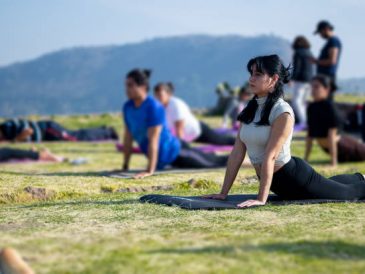Yoga, a centuries-old practice originating from ancient India, has gained immense popularity worldwide for its holistic approach to physical, mental, and spiritual well-being. While yoga offers numerous benefits, including improved flexibility, strength, and stress reduction, practitioners may encounter discomfort or pain during their practice. Understanding the causes of yoga-related pain and employing effective remedies are crucial for a safe and fulfilling yoga experience.
Understanding Yoga-Related Pain:
a. Overexertion and Poor Alignment:
Many practitioners experience pain due to overexertion or incorrect alignment during yoga poses (asanas). Pushing the body beyond its limits or holding poses with improper alignment can strain muscles and joints, leading to discomfort or injury.
b. Pre-existing Conditions:
Individuals with pre-existing physical conditions, such as chronic pain, arthritis, or injuries, may find certain yoga poses exacerbate their discomfort. It’s essential for practitioners with such conditions to approach yoga mindfully and seek modifications or alternative poses.
c. Emotional Release:
Yoga can also serve as a catalyst for emotional release, triggering buried emotions or tension stored within the body. This release process may manifest as temporary discomfort or even tears during practice.
Recognizing Types of Pain:
a. Acute Pain:
Acute pain occurs suddenly and is typically sharp or intense. It may indicate immediate strain or injury and should be addressed promptly to prevent further damage.
b. Chronic Pain:
Chronic pain persists over time and may be dull or recurring. It often stems from underlying conditions or long-term muscular imbalances and requires careful management and modification of practice.
Treating Yoga-Related Pain:
a. Listen to Your Body:
The most crucial aspect of pain management in yoga is listening to your body’s signals. If a pose feels uncomfortable or painful, honor your body’s limitations and ease out of it. Pushing through pain can exacerbate injuries and hinder progress.
b. Modify Poses:
Modify poses to suit your body’s needs and limitations. This may involve using props like blocks, bolsters, or straps to support alignment or adjusting the depth and intensity of poses to reduce strain.
c. Focus on Breath and Relaxation:
Incorporating breathwork (pranayama) and relaxation techniques, such as meditation or guided imagery, can help alleviate tension and promote relaxation, reducing the likelihood of experiencing pain during practice.
d. Seek Professional Guidance:
Consult with a qualified yoga instructor or healthcare provider if you experience persistent or severe pain during yoga practice. They can offer personalized guidance, modifications, or referrals to address underlying issues.
e. Practice Mindfulness:
Cultivate mindfulness and body awareness to prevent overexertion and promote safe alignment. Pay attention to sensations in your body during practice and learn to differentiate between discomfort that signals growth and pain that indicates potential injury.
Preventing Future Pain:
a. Warm-Up Properly:
Begin each yoga session with a gentle warm-up sequence to prepare the body for more intense poses. Dynamic movements, such as sun salutations, can increase blood flow and flexibility, reducing the risk of injury.
b. Gradually Progress:
Avoid rushing into advanced poses before mastering foundational ones. Progress gradually, respecting your body’s limitations and building strength and flexibility over time.
c. Balance Strength and Flexibility:
Strive for a balanced yoga practice that incorporates both strength-building and flexibility-enhancing poses. Imbalances between strength and flexibility can lead to compensatory patterns and increased risk of injury.
d. Practice Self-Care:
Implement self-care practices, such as adequate rest, hydration, and nutrition, to support your body’s recovery and resilience. Prioritize rest days and listen to your body’s need for recovery between yoga sessions.
Conclusion:
Yoga offers a transformative journey of self-discovery and holistic well-being, but it’s essential to approach the practice mindfully to prevent and address yoga-related pain. By understanding the causes of discomfort, recognizing different types of pain, and employing effective remedies, practitioners can cultivate a safe and fulfilling yoga practice that nurtures body, mind, and spirit. Remember, yoga is not about pushing through pain but rather about honoring the body’s wisdom and finding balance and harmony within oneself.




